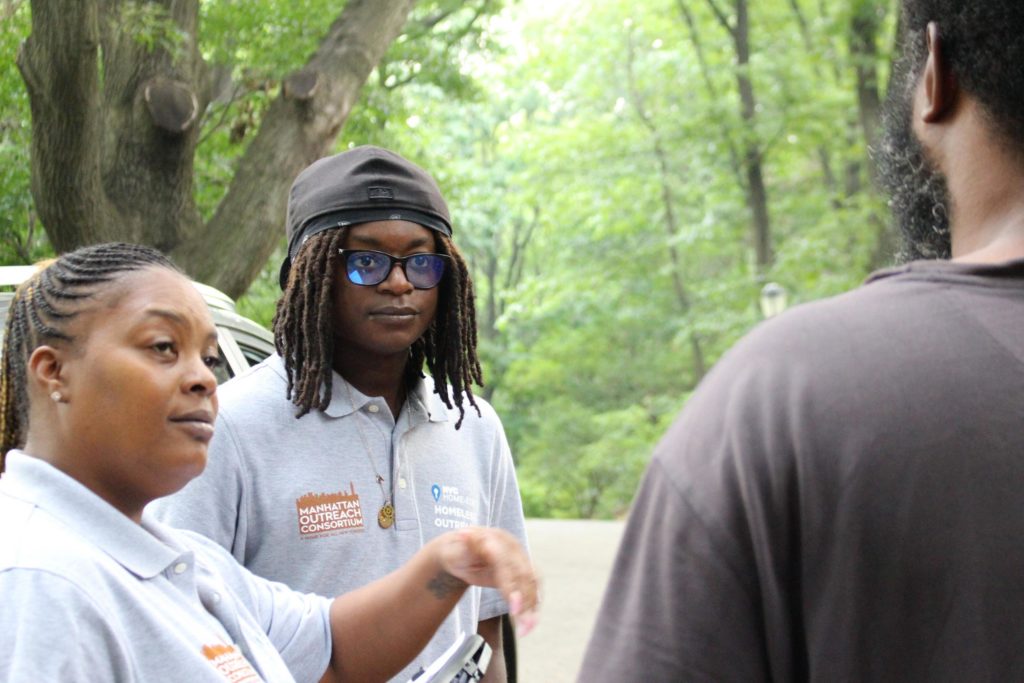Names and identifying details in this story have been changed to protect privacy.

At 6:30 on a warm, clear Wednesday morning, sleepers still occupy most of the stone benches in Columbus Circle. They slumber under cardboard, newspapers, or plastic sheeting. Most have a shirt or sweatshirt over their heads to block out the sun Ñ and perhaps the eyes of passing joggers and dog-walkers too.
“Good morning,” says Gavin Wilkinson gently. “Sorry to wake you.”
A young man’s head emerges from under a piece of worn canvas.
“Are you in need of housing? Do you have a place to stay?”
The man Ñ we’ll call him Terry Shaw Ñ shakes his head and props himself up on his elbows. He has been homeless for a month, he tells Wilkinson: “I got kicked out of my house by my mom and her husband.”
As they keep talking, Wilkinson’s teammate Keiamesha Wilson takes notes on her clipboard. She asks Shaw whether he has a photo ID or needs help getting one. Does he have a job?
He sits up further and points to his shirt, which carries the name of a delivery service. He’s sleeping in his work clothes.
This is the first contact of the day for Wilkinson and Wilson, and it’s an unusual one, because Terry Shaw is new to the Homeless Outreach program. The pair will talk to a total of 40 people this morning; all but two will already be on their rolls.
Wilson records Shaw as a being “bedded down” in public. Once they’ve documented that Shaw is living on the street Ñ which includes being seen sleeping outside several times Ñ he’ll be assigned a case manager, who will work with him to apply for government services and find permanent housing. She makes sure to ask him if there are other places where he sleeps.
“People move around,” she explains later. “Something might happen overnight and they don’t feel safe in that location anymore.” When they move to a new spot, they can be hard to find again.
Once they’ve taken Shaw’s information, Wilson and Wilkinson promise to check back on him in the same place tomorrow. Then they approach the sleepers on the rest of the benches. Some people just shake their heads no. One woman pulls a scarf over her eyes and turns her face away. A man with four loaded shopping carts glares and walks off, rolling a cart with him.
“It’s summer but sometimes we still get the cold shoulder,” says Wilkinson with a wry smile.
Sometimes, though, they get to deliver good news. “Tomorrow we’ll meet with you to start applying for services,” Wilson tells a man eating Cheerios from a single-serving packet that looks like it’s been scavenged from the trash.
The man brightens. “How soon can I get food stamps?” he asks. He looks relieved when he’s told he’ll probably receive food aid right away.
When they’ve finished canvassing the traffic circle and the entrance to Central Park, the team jumps in a dark-green outreach van and heads uptown. They stop frequently to seek out people on benches, under scaffolding and in parks. They deliver messages from their fellow case managers and take notes to bring back to them. When all other assistance is refused, they still offer something that can be hard to come by on the streets: a smile and a friendly word.
“Stop by the office, even if it’s just to get a t-shirt or whatever,” Wilkinson tells an older man wearing a baseball cap and camouflage shorts.
“Oh, I don’t need your services but I still have your card,” the man answers jovially. He asks after another member of the team: “How’s Paulique? Is she still with you?” They talk like old friends.
Wilkinson makes sure to find out where the man is sleeping. “We’re around if you change your mind, okay?” he says as he gets back in the van.
It can take months or even years of interactions like these to persuade a person experiencing homelessness to accept help. People may say no because of mental illness, or because they’ve had a bad experience with government services before. They may be unready to trust offers of aid.
“It’s all about persistence,” Wilkinson explains. “You build a relationship.”
“Sometimes you have to help with lower-level needs before you can get to housing,” Wilson adds.
The end goal is to help people move into permanent supportive housing, which offers services to smooth the transition to apartment living. After years of being on the streets, people often need to relearn skills like cleaning, cooking and doing laundry. In supportive housing, case managers help them reconnect with their families and community, and find jobs. The goal is for each resident to be healthy, integrated with the community, and as independent as possible.
Goddard Riverside offers four supportive housing residences on the Upper West Side and in Harlem. Most people who enter them do well; after a year, more than 90 percent are still housed. If you passed them in a crowd, you’d never know they had been homeless.
Back in the office, Wilson update files on each of the 40 people in a database shared with the other agencies in the Manhattan Outreach Consortium. The MOC, which was founded by Goddard Riverside in 2007, provides outreach for all of Manhattan. Its partner agencies work together in an effort to ensure no-one falls through the cracks.
She opens up a new entry for Terry Shaw. “Client was observed bedded down at above location,” she types. It’s a small step — but one that may lead to a better life.